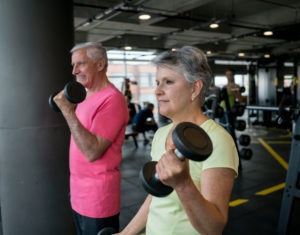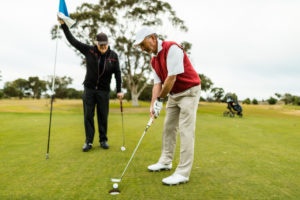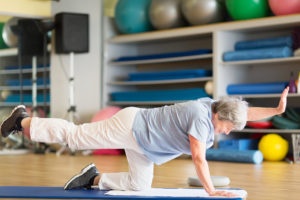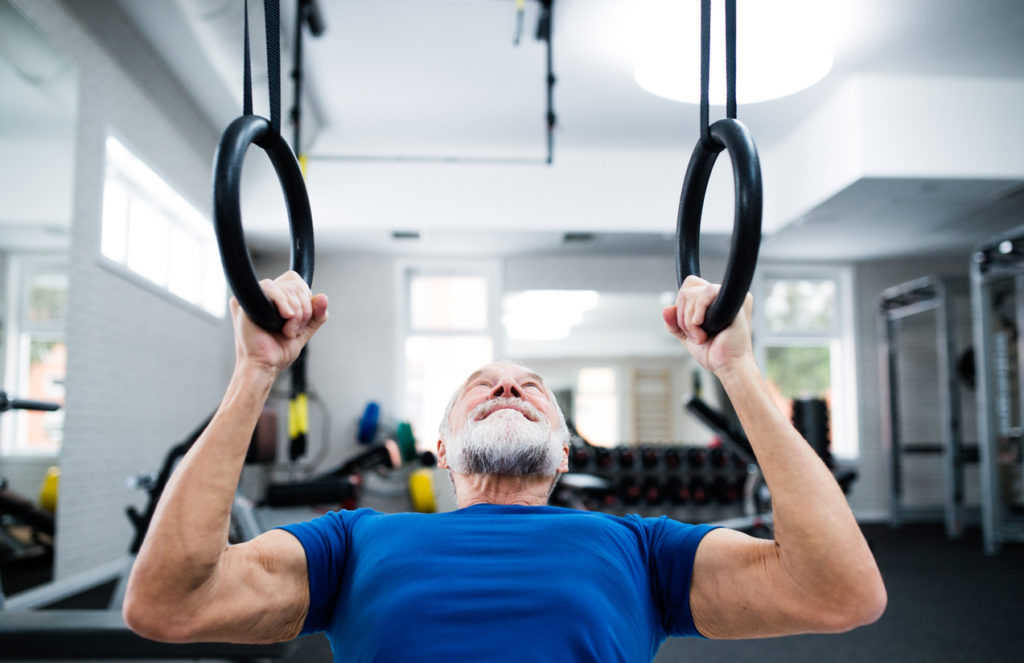Age is more than a number- it’s an opportunity to serve a growing population.
Every day we are bombarded with statistics on seniors and baby boomers, and the customer potential they can bring. But what do trainers (or club owners) need to consider before they try to capture this market? What are the expectations of the senior customer? What services can you offer? Are you or your staff qualified, and comfortable, to work with the older adult market? Is your facility set up to safely meet their needs?
According to the US Census Bureau for 2015, 47.8 million (or 14.9% of the nation) people are 65 and older. To expand that, baby boomers, those born between 1946 and 1964, are predicted to number in the 72 million range in 2019 and these baby boomers have no intention of slowing down for age.
Essentially, there is not a typical senior client. They each bring their own capabilities and limitations, pushing what may be the “norm” for their chronological age. Physiologically, your older clients (55+) may be experiencing the following:
- Decreased Muscle Mass (Atrophy): Many seniors tend to lead less active lifestyles resulting in a higher incidence of muscle atrophy (1). Studies show that resistance training has a positive effect on improving muscle strength and size in older adults (1-4).
- Decreased Balance and Coordination: With aging comes a decreased ability to balance and coordinate movements that can be caused by a variety of factors including, but not limited to, visual impairments, vestibular (inner ear) challenges, decreased sense of touch or feeling, neurological conditions, and a variety of medications, just to highlight a few possible causes. Sometimes used interchangeably, balance refers to being able to keep the center of gravity over your base of support whereas coordination is controlling the speed, distance, and timing of various body segments in space. Both are important for movement.
- Decreased Flexibility: The aging process also brings a stiffening of the connective tissue system resulting in decreased range of motion and altered joint motion. This can play a major role in how your older adults perform their exercises. Exercises should be performed in the range of motion that can be completed without compensation or pain (5).
- Decreased maximal heart rate, decreased cardiac output, reduced bone density, and because this list can go on and on, it is one of the reasons why completing thorough health histories and assessments are vital to working with this group (5).
Seniors are motivated to exercise for many reasons. Some are looking for general health and wellness benefits, weight loss help, core strength, or opportunities for social interaction. Others may be participating due to a fear of losing their independence if they can’t physically care for themselves. Exercise has been shown to significantly improve confidence in older adults and those who keep active are also less likely to experience psychological distress (6-7). Regular exercise positively benefits seniors with improved emotional wellbeing, decreased stress, improved mood, and decreased symptoms of depression and anxiety.
Plan senior programming options during the slower, less-crowded club hours-depending on your club, this is typically the mid-morning to early afternoon hours, versus when the younger employed members are actively using the facility. Seniors usually have a more flexible schedule since many have left the workforce. Senior specific programming can fill those lull times, and offer personal trainers and group instructors an opportunity to fill their own schedules by focusing attention on this group. 
Seniors may feel more comfortable and less self-conscious when the club is less busy and noisy. Make them feel welcome during these hours by adjusting the music to something a little less jarring and keeping exercise areas clear of abandoned dumbbells and other small equipment pieces that could become a fall hazard. Take a look around your facility, both inside and out, to determine if there are other obstacles or hazards that can be fixed or adjusted.
Older adults may be interested in programming that addresses balance training and fall prevention. One of the greatest fears of older adults is fear of falling, especially with the statistic that over 28% will fall, and that 37.5% of those resulted in the need for medical attention or loss of activity. Strength training has been shown as a viable intervention in preventing a second fall, and potentially reducing the occurrence of a first fall.
Group exercise formats tailored to seniors are also another option, with the added benefit of social interaction. Partner up to offer branded programs or develop your own unique blends of senior friendly classes like seated aerobics or strength, yoga, tai chi, water fitness, or sport-specific programs. Keep the atmosphere fun so your seniors will keep coming back.
For your more active seniors and baby boomers, golf conditioning programs may be what inspires them to join. The 2010 Golf Participation in the United States survey published by the National Golf Association indicates 16.4% of the nation’s golfers are over 60, and over 30% of all golfers have an annual household income over $100,000 (8). Promote your golf conditioning services at local golf courses and driving ranges, or sponsor holes at local tournaments. Studies have shown golf-specific fitness training programs can improve driving distance, accuracy, putting performance and decreased injury rates (9).
 Training can help golf players lower their score.
Training can help golf players lower their score.
Nearly three-fourths of Americans 50 or older want more information about exercising safely, and more than half want individualized exercise plans (6). These are impressive numbers, but there are barriers that keep seniors from participating, such as discomfort, fear of injury, and fear of intolerance from fitness professionals.
Trainers and club staff need to develop the knowledge and skills necessary to work with older exercisers to reduce these barriers. Enhance communication and rapport building skills so seniors know trainers and staff are there to help them meet their specific goals. Always maintain CPR/AED credentials and keep up-to-date with the clubs emergency procedures.
Trainers should be able to progress or regress activities based on the older adult clients’ ability level, and how they may feel during that session at that particular time. Focus on training techniques appropriate for each client’s particular needs and goals. According to IHRSA’s “Health Club Consumer Report: 2011 Health Club Activity, Usage, Trends & Analysis,” the average personal training fee paid by members over the age of 65 was $33.53 per session. Even though this is less than the average fee for other age groups, training seniors at a lower rate is an opportunity to generate revenue during otherwise empty time slots. 
Promoting your services to seniors and baby boomers is an opportunity to reach a growing demographic. Be prepared with programming (and a knowledgeable staff) that can meet their needs-physically, emotionally, and economically. Work to develop the skills and knowledge to better serve the older adult members in your club and community. NASM offers the Senior Fitness Specialist course to help you meet seniors’ specific needs by designing exercise programs that use NASM’s Optimum Performance Training™ (OPT™) program.
References
(1) Newton RU, Hakkinen A, Hakkinen M, et al. Mixed-methods resistance training increases power and strength of young and older men. Med Sci Sports Exer 2002;34(8):1367–1375.
(2) Izquierdo M, Ibanez J, Hakkinen WJ, et al. Once weekly combined resistance and cardiovascular training in healthy older men. Med Sci Sports Exer 2004;36(4):435-443.
(3) Hagerman FC, Walsh SJ, Staron RS, et al. Effects of high-intensity resistance training on untrained older men. I. Strength, cardiovascular, and metabolic responses. J Gerontol A Biol Sci Med Sci 2000;55:B336–B346.
(4) Tracy BL, Ivey FM, Hurlbut, D, et al. Muscle quality. II. Effects of strength training in 65- to 75-yr-old men and women. J Appl Physiol 1999;86:195–201.
(5) National Academy of Sports Medicine. Optimum Performance Training for Seniors Course Manual. Calabasas, CA: 2005.
(6) National Academy of Sports Medicine. Senior Fitness Specialist. United States: 2012.
(7) Yorston, L. C., Kolt, G. S. and Rosenkranz, R. R. (2012), Physical Activity and Physical Function in Older Adults: The 45 and Up Study. Journal of the American Geriatrics Society, 60: 719–725. doi: 10.1111/j.1532-5415.2012.03906.x.
(8) National Golf Foundation. Golf Participation in the United States 2010 Edition. Jupiter, FL.
(9) National Academy of Sports Medicine. Golf Fitness Specialist Course Manual. United States: 2012.
<Rev 4.18>











